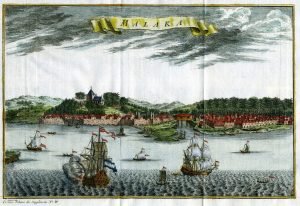Edward Pakenham
Died 1798. He was the son of Edward Pakenham and Elizabeth Weller, and the brother of Vice-Admiral John Pakenham. His grandfather was Rear-Admiral John Weller.
Pakenham was promoted lieutenant with seniority from 17 July 1777, and in 1778 commissioned the American merchant vessel Viper as a 10-gun schooner. He commanded this vessel in the Philadelphia Campaign from 25 August, and in December he was instructed by Captain Andrew Snape Hamond of the Roebuck 44 to rescue the contents of a transport that had gone aground in the Delaware.
Promoted commander on 9 April 1783, he had the sloop Zebra 16 in the Leeward Islands during the next two years and in 1785 at Newfoundland, prior to leaving her later that year. In 1786 he recommissioned the sloop Merlin 18, which vessel he paid off in February 1789 having seen annual service at Newfoundland.
Pakenham was one of the many officers posted captain at the end of the Spanish Armament in 1790, with his seniority being dated 22 November. In July 1791 he was brought to a court martial at Portsmouth on charges laid be his lieutenant, presumably relating to an earlier employment, of embezzlement of stores, keeping false musters, tyranny and oppression, un-officer-like and un-gentleman-like behaviour, and false expenditure of stores . After several days in court he was most honourably acquitted when the charges were deemed cruel, malicious, and ill-founded .
In the autumn of 1793 he fitted out the Resistance 44 at Plymouth from where he set sail at the end of November, and having taken a convoy out to Cadiz he voyaged on to the East Indies with the Orpheus 32, Commodore Henry Newcome, and Centurion 50, Captain Samuel Osborn. . In October 1794 the Resistance captured the French sloop Revanche 18 in the Straits of Sunda, which vessel was sent into Madras and bought into the Navy as the Hobart. During the campaign that resulted in Rear-Admiral Peter Rainier s capture of Trincomale on 26 August 1795 Pakenham was detached to join Captain Henry Newcome’s expedition against Malacca in the Dutch East Indies. This mission proved successful on 17 August, but not before two headstrong junior officers, Lord Camelford and Nesbit Willoughby, had recklessly attempted to board a Dutch armed ship, requiring Pakenham to rescue their two boats by forcing the Dutchman to strike after a long-range barrage.
During February-March 1796 he commanded the Resistance in the expedition which captured the islands of Amboyna and Banda, securing himself 15,000 in prize money, or the equivalent of 1.75m in today s money. In 1797, whilst operating out of Amboyna, the Resistance took a number of Dutch prizes in the East Indies, including three of ten guns, these being the Yonge Frans, Yonge Lansier, and Waaker.
In November 1797 Pakenham sailed for China from Amboyna to seek provisions for the Resistance s crew, as they were subsisting on short and decayed provisions, and the sick-list numbered over a hundred men. On passage she was overtaken by a typhoon that caused her to ship so much water that Pakenham had to make for the nearby Spanish island of Panay in the Philippines. Entering port under Spanish colours, he detained the launch that came out to meet the Resistance with the promise that it should be released in return for a modest amount of food and water, but the Spanish refused to help and indeed opened fire with a battery on the next morning. Having been struck by two mighty 48-pound balls Pakenham made off with a Spanish brig that had been boarded whilst anchored nearby, and after losing another four men to Malays at Balambangan Island he eventually reached Limbe in modern day Indonesia where he was able to re-provision.
On 24 July 1798, the Resistance took fire and blew up in the Straits of Banca off Sumatra with the immediate loss of all but thirteen lives. The only survivor to reach civilisation was released from slavery to the British garrison at Malacca, with the remainder either dying in the succeeding days or being imprisoned by the Malays.
Unmarried, Pakenham formed a liking for the temperamental Lieutenant Lord Camelford and made the best of his abilities. He was the inventor of the Pakenham Rudder , a rudimentary substitute for a lost rudder constructed out of ordinary ship stores, and was also the designer of a method for restoring to use wounded masts in an economical and prompt manner. At the time that the Resistance was commissioning at Portsmouth in the autumn of 1793 one newspaper reported that a happier ship s crew perhaps never sailed from Spithead , this being an incontrovertible proof, that all the purposes of discipline maybe obtained without unnecessary severity .

